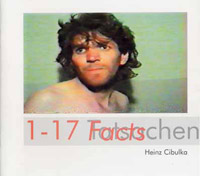|
... publikationen | publications |
|
|| menu || |
| deutsch | |
|
1-17 Facts/Tatsachen Austrian Cultural Institut, London, 1997; 12 pages / 8 pages picture and
computer collages and a text by |
In this cycle I wanted to undermine and expand the compositional principles that have been typical of most of my photographic works so far. Whereas my better known works consist of entire cycles of blocks of four photographs mounted together I have here used 17 different compositions of images. The individual elements of these compositions - video stilis, digitally stored photographs, Computer graphics of numbers and letters - were printed out as ink jet prints or laser copies by computer-controlled printers and copiers. By juxtaposing these images in different ways I have wanted to explore the similar and divergent effects of constellations of images. In addition to the single image as a valid statement 16 further variations on a strictly limited theme show how individual images can function like vocabulary items within larger or smaller units of a pictorial language. The quality of the concrete lies in its mystery, in the state of suspense of possible meanings Reality as we experience it can be turned into artistic statements by our system of perception. Storing sections of this reality by way of photographic signs and in our brains, if possible from different viewpoints. Perceiving many such sections by as many difterent registering sites of our mental apparatus as possible. Repeatedly passing through the different points of approach of the images. The multidimensional reality, the reality of the photograph as an image on paper, its image in our heads, the image which my neighbour, a bird or a billygoat might form as I imagine it, ... all conceivable points of approach are involved and are aspects of reality. The visual reverberations make the first impression of immediate perception seem like an exposed photographic paper on which images appear like monumental spectres, inscribing themselves as signs. Each photographic composition is created in the hope of achieving a poetic intensity The photographic images are signs that are related to each other poetically on the level of ideographic messages. The artistic intention is to be sought in the sequence and juxtaposition of the various images. There is no logical sequence of a necessarily valid interpretation. The poetic meaning of these pictorial poems is in the spectator's reading - between the images. A photograph that becomes an element of a pictorial poem is divested of its reference to its original model. Since lt takes on a new reality its sense and meaning in terms of photographic reality are denved from its utilisation in the pictorial poem. The deployment of an image is determined by the constant of its collective level of meaning. It is on this that the orientation and reorientation are based. It is a matter of challenging and shifting this order and these concepts of order. I am trying to provide open compositions that fulfil themselves in their creative interpretation and deciphering. The images offered seek their formative eftect in the spectator's wealth of images and interpretations. In its function as a sign each individual image triggers feelings and appeals to different levels of our perceptive apparatus. In their relationship to each other the juxtaposed images touch oft a spate of lively associations, emotions and ideas. |






